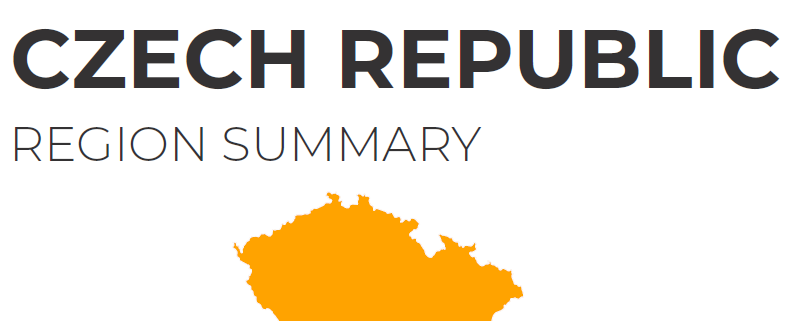Market Landscape
What are the major corporations across sectors that have decision-making units based in the region?
Axis Communications, 2N, Linet (HQ), Hartmann Rico, Viscofan, T-Mobile, Vodafone, Volkswagen, Hyundai, Pilsner Urquell (HQ), Budejovicky Budvar (Original Budweiser) (HQ), Unicredit Bank, Raiffeisen Bank, Kofola (HQ), Lidl, Tesco, Albert, Kiwi.com (HQ), Skype
What are the “hottest sectors” for startups?
3D printing, hardware (incl. gadgets), software (systems), IoT, programming (apps, web), game development (computer and online games).
What kind of sectors are the rising stars in the local economy?
Old stars (still doing great): chemical, automotive PR, green tech PR. New stars: smart… (home, cities, transport), fintech PR, gaming PR, (quality) food and drink PR, design.
Communication Environment
What holds sway in your region – traditional or new media types and influencers? How is that changing?
The traditional media are still the strongest. TV – 1st, online – 2nd, radio + print – 3rd. In numbers, about 65 percent of the population (18 – 59yrs) consume traditional media on a daily basis. The younger the generation, the less this is the case – only 52 percent in the 18 – 29 age group.
However, social media (including the reach of influencers) is growing as a sector. In general, about 50 percent of the population use social media (influencers) as a source of information. Age again is the key:
- 73 percent 18-29yrs,
- 54 percent 30-44yrs,
- 31 percent 45-59yrs.
What is the influence ecosystem – the media, analysts, consultants and non-traditional influencers (bloggers etc.). And where to start in this ecosystem?
It is very individual, depending on the product and the age group. It is ideal to complete the circle with content and digital marketing.
The most powerful tools in communications are: traditional media, social networks: Facebook, Instagram, YouTube, brand journals (own media, own Facebook pages, own social networks) sponsored posts and AdWords.
Special:
- There is a very well developed community on Twitch – especially in terms of gaming and consumer & lifestyle.
- Czech Twitter is great for news rich sectors, especially technology and politics, but also some from lifestyle: fashion and food & drink.
- Linkedin: HR, industry relations
Weak performance:
- Blogs
- Analysts without a strong media or social media presence
- Snapchat
What kind of stories tends to dominate influencer/media attention? What type of stories receive little attention?
As always, you have to have a specialist who knows what to expect from the said influencer. At this time it is very rare for influencer cooperation to be fee free. This means that to engage them you have to have at least a little cash (or a trip to the Moon to cover).
Type of Content: Mainly that which seems worthy, special or exclusive to them. A sneak-peak into a new product, behind the scenes access, extreme fun (crash tests). It is also great to invite journalists or influencers to join the creative process.
There are some actions that will not generate any attention, like press releases, a non-individual approach or censorship.
Communication Tools
What communication tools are the best to use in your market – media relations, social media, employer branding, events, content marketing, etc.?
All of them. Social media – as mentioned above – plus digital marketing and content marketing. Corporate media (corporate webs, clubs, magazines, Facebook groups etc.) is also strong.
What kind of communication software are you using in your daily activities? (media and social media monitoring, CRMs, knowledge management, project management, news distribution software, etc. – give names ).
Media monitoring:
- Monitora
- Newton Media
CRM:
- Feeio (own system)
Knowledge management:
- Google Docs
Project management:
- BaseCamp
- Slack
News distribution software:
- Pressofice (own system)
Examples
Do you have any “horror stories” or anecdotes that demonstrate contemporary PR/communication practice in your region?
The “Silent” client: this happens with every 5th new client, where the client wants to be all over the media but does not share any story with us or approves of any we generate. Sometimes, it may actually be the case that there isn’t any story, but mostly the client does not make the effort to find one or work with us to develop one.
Example: An online reservation system. It had thousands of clients, it was a good system. They were not able to provide any of their client’s stories – first, they did not want to share any of their contacts: we got them ourselves. Then, they did not give us permission to use them, saying they would provide some better examples. This, of course, never happened. They didn’t provide us with any other data.
The cooperation ended after 3 months, with the client complaining that there had been too little publicity – we were able to sneak them into some stories about how online services can change lives, using some made up clients of theirs.
Wild YouTubers: we have very good relations with influencers and YouTubers, especially in the gaming and tech sectors. However, we are not always able to make a good match.
Our client in computer security (antiviruses) wanted to cooperate specifically with only one YouTuber. The YouTuber was not interested. We had some other, much better options, but the client did not want anybody else. So, they paid the YouTuber directly.
The outcome: The YouTuber made a story about something completely different with the box of the company product (sometimes it still comes in a box) on his head all the time.
The characteristics of Czech Republic market prepared by: TAKTIQ COMMUNICATIONS

